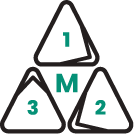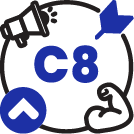We don’t need to tell you how invaluable Partners are in the GTM strategy. Not only can they open doors for you into areas you might not be as familiar with, their knowledge can provide you with key insights to help you get ahead.
It is essential for the Partner to be on the same page as the in-house GTM team, as they act as each other’s extension when collaborating. As your Partner is unlikely to be as much of an expert regarding your solution as you are, it is especially important to have a framework in place to help manage the processes and to articulate your value to the right stakeholders. MEDDPICC can empower even better collaboration between the Partner and the broader team, and will clearly allow you to identify what the right things are to do next in the deals you work on together. As we’ve seen in previous instalments of this series, with MEDDPICC serving as a common language, the GTM team can move through the Customer Lifecycle with ease.
How can the Partner use MEDDPICC?
During the Selling stage:
Partners can use Metrics to articulate the proven value of your solution that has previously been delivered to potential customers. Early on, they can use M1s, and later in the Customer Lifecycle the Partner can work alongside the AE to build towards M2s, all in collaboration with the customer. We have discussed both M1s and M2s in previous instalments of this series, but in case you need a refresher:
M1s use proven and relevant value from your existing customer base to enable your prospective customer to rapidly capture understanding of the value you provide. As the Godfather of MEDDIC Jack Napoli says, you want to show your customer someone else’s ugly baby before calling their baby ugly. What this means is that M1s allow you to demonstrate real value that your solution has brought to other customers and problems you’ve solved, rather than you turning to your customer and pointing out everything they do wrong and how you can fix it. help. This helps to overcome what we call the ‘Discovery Paradox’, where you know you need to qualify the deal while simultaneously avoiding calling their baby ugly or going in and pitching blind. Using research-based M1s during early stages puts you in the ideal position to avoid the Discover Paradox and encourage the customer to open up when it comes to their pain. You can then work together to understand whether they are willing and able to go into a mutual evaluation regarding your solution.
M2s, in turn, are tailored to the individual customer. The Partner’s probable pre-existing relationship with the customer can really aid your GTM team in the use of M2s, as they involve discovering measurable value that your solution can provide the customer. When a rapport has been established with the customer, the Partner can work with the SaaS vendor or tech company to delve deeper and find real ways your solution can help the customer - something that is best facilitated by collaboration between the Partner and the rest of the GTM team
Using Metrics allows the Partner, as part of the GTM team, to demonstrate to customers the real value your solution provides. In addition to that, since the Partner may not know your solution as well as you, it gives them serious evidence to fall back on should they need it.
The Partner’s expertise can be helpful when influencing the Decision Criteria. Therefore, it is incredibly important for the Partner to have a clear understanding of how your solution is differentiated from others on a technical, economic, and relationship basis. When the Partner doesn’t assume that the customer has clear Decision Criteria, but rather that they are made between Champions and trusted advisors, you and your partner will have yet another edge from a competitive and value delivery perspective.
During the Closing stage:
Partners can work with the rest of the sales team to work through the Decision Process. If they are familiar with the customer organisation, Partners can shed some light early on as to what the customer’s Decision Process looks like. This way, when it comes to Closing, it is clear what steps the customer will take to make a decision, as well as how you and your partner can best collaborate on improving the efficiency in the deal process and shorten your overall Time to Close. Time to Close is a key factor in the Sales Velocity Equation that can impact the rate at which your business generates revenue. Her's our article on Sales Velocity Equation for extra insights.
It is important to remember that when it comes to the Decision Process that more engagement with the customer does not necessarily mean your business is the preferred vendor. Measuring the progress made against their Decision Process is a clearer way of indicating whether a deal will be successful than the number of meetings or calls you may have with a customer.
It is equally important for the Partner to be involved in the Paper Process, as not having a clear understanding of the Paper Process early on creates a risk of the deal slipping later on. Along with other members of the GTM team, the Partner can proactively work through the Paper Process, and ensure compliance with the customer’s requirements throughout the Customer Lifecycle. A useful way to uncover the Paper Process is to ask the customer what the necessary steps were the last time they ‘bought a similar product or solution’, along with engaging with the right stakeholders to ensure clarity on the overall process. Because the Paper Process typically follows the selection of your company as the preferred vendor, the sooner the Paper Process is completed, the sooner your deal is closed!
Outside of the specific steps outlined above, Partners can use MEDDPICC alongside the sales team throughout the Customer Lifecycle. In both the Awareness and Prospecting stage and the Growth and Retention stage, Partners can be a force multiplier due to their ability to come together and align best with regards to Value, Process, and Stakeholders.
As you can see, having MEDDPICC as a common language will allow you to level up and empower you to focus on the right things as one team. This then produces a sales team that works like a well-oiled machine throughout the Customer Lifecycle.
Come back next time for the following instalment on Marketing!





.png)





.png)
























%201.png)








.png)

.png)
.png)
